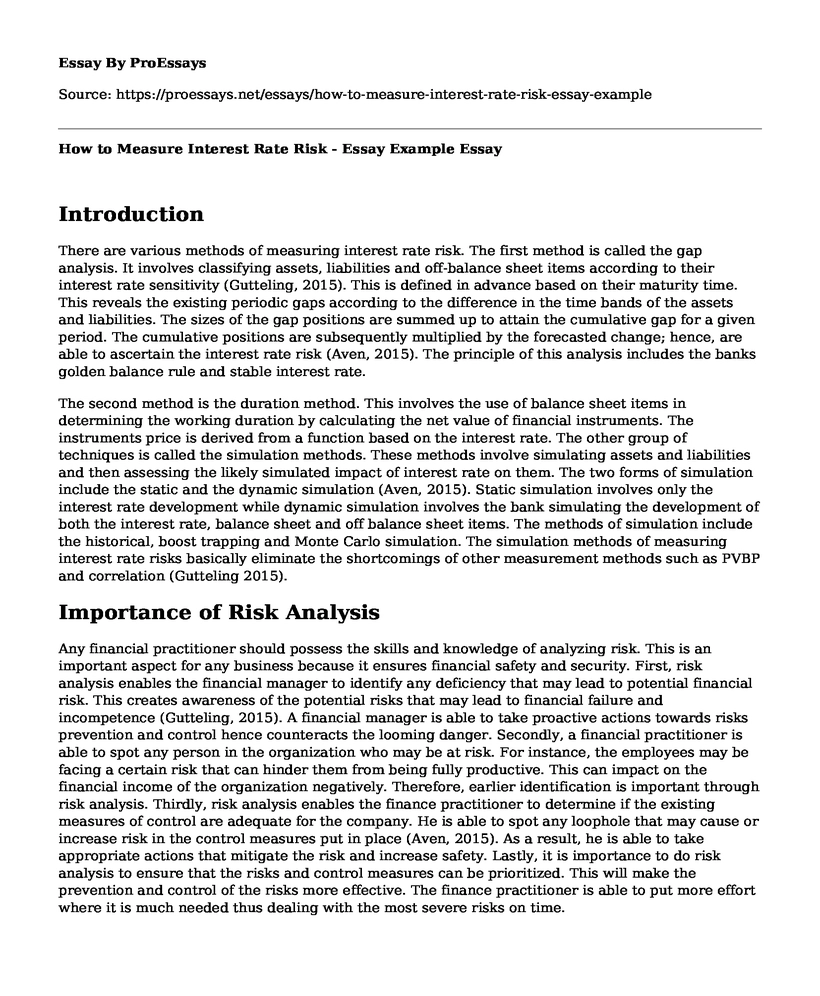Introduction
There are various methods of measuring interest rate risk. The first method is called the gap analysis. It involves classifying assets, liabilities and off-balance sheet items according to their interest rate sensitivity (Gutteling, 2015). This is defined in advance based on their maturity time. This reveals the existing periodic gaps according to the difference in the time bands of the assets and liabilities. The sizes of the gap positions are summed up to attain the cumulative gap for a given period. The cumulative positions are subsequently multiplied by the forecasted change; hence, are able to ascertain the interest rate risk (Aven, 2015). The principle of this analysis includes the banks golden balance rule and stable interest rate.
The second method is the duration method. This involves the use of balance sheet items in determining the working duration by calculating the net value of financial instruments. The instruments price is derived from a function based on the interest rate. The other group of techniques is called the simulation methods. These methods involve simulating assets and liabilities and then assessing the likely simulated impact of interest rate on them. The two forms of simulation include the static and the dynamic simulation (Aven, 2015). Static simulation involves only the interest rate development while dynamic simulation involves the bank simulating the development of both the interest rate, balance sheet and off balance sheet items. The methods of simulation include the historical, boost trapping and Monte Carlo simulation. The simulation methods of measuring interest rate risks basically eliminate the shortcomings of other measurement methods such as PVBP and correlation (Gutteling 2015).
Importance of Risk Analysis
Any financial practitioner should possess the skills and knowledge of analyzing risk. This is an important aspect for any business because it ensures financial safety and security. First, risk analysis enables the financial manager to identify any deficiency that may lead to potential financial risk. This creates awareness of the potential risks that may lead to financial failure and incompetence (Gutteling, 2015). A financial manager is able to take proactive actions towards risks prevention and control hence counteracts the looming danger. Secondly, a financial practitioner is able to spot any person in the organization who may be at risk. For instance, the employees may be facing a certain risk that can hinder them from being fully productive. This can impact on the financial income of the organization negatively. Therefore, earlier identification is important through risk analysis. Thirdly, risk analysis enables the finance practitioner to determine if the existing measures of control are adequate for the company. He is able to spot any loophole that may cause or increase risk in the control measures put in place (Aven, 2015). As a result, he is able to take appropriate actions that mitigate the risk and increase safety. Lastly, it is importance to do risk analysis to ensure that the risks and control measures can be prioritized. This will make the prevention and control of the risks more effective. The finance practitioner is able to put more effort where it is much needed thus dealing with the most severe risks on time.
Numerical Application
Use of numbers is important when carrying out risk analysis. This is because different levels of risk can be determined by assigning numerical values (Aven, 2015). It involves the adoption of several techniques, mathematical models and methods from different disciplines. As a result, the assessment becomes more valid and reliable (Gutteling, 2015). Moreover, I find the quantitative examination of risk more useful as it focuses on details and eventually enables the financial expert to understand the prevailing market conditions. Markedly, analysts are able to use discrete outcomes when making their conclusions.
References
Aven, T. (2015). Risk analysis. John Wiley & Sons. Print
Gutteling, J. M. (2015). Risk communication. John Wiley & Sons, Inc. Print
Cite this page
How to Measure Interest Rate Risk - Essay Example. (2021, Apr 05). Retrieved from https://proessays.net/essays/how-to-measure-interest-rate-risk-essay-example
If you are the original author of this essay and no longer wish to have it published on the ProEssays website, please click below to request its removal:
- The Stock Performance of AmerisourceBergen Corporation Case Study Example
- General Industry Insurance Overview - Article Analysis Essay
- Single-Payer Bill Paper Example
- Essay Sample on Investment in the Internet of Things
- Technology and Innovation in Banking and Finance Essay Example
- Post-Investment Hold-Up: Sunk Cost, Contract, Breach, Damages - Essay Sample
- Essay Example on UAE's Securities and Commodities Authority: Protecting Investors and Growing Economy







